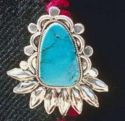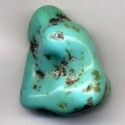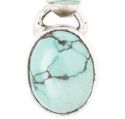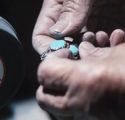Turquoise
From Giftypedia

|
Turquoise is the birthstone of December.
It is also considered the planetary stone of Aquarius and the astrological birthstone for both Taurus and Sagittarius. [edit] What is TurquoiseTurquoise is a copper aluminum phosphate with a Mohs scale of 6, making it one of the softer gems. Such relative softness makes turquoise sensitive. The color of even high quality stones will pale when worn for a long time. Because of this, the stones are treated with wax to harden them. |
[edit] Mystical Uses of Turquoise
The turquoise gemstone has been esteemed for thousands of years as a holy stone, a bringer of good fortune or a talisman.
In Egypt, grave furnishings dating from 3000 B.C. were decorated with turquoise[1].
Legend has it that some Native Americans believed that if turquoise was affixed to a bow, the arrows shot from it would always hit their mark.
In Asia, turquoise was considered a protection against the evil eye.
In ancient Persia, turquoise was worn around the wrist or neck to protect against unnatural death. The wearer feared the approach of doom if the stones changed color.
Egyptians considered turquoise to be a symbol of rebirth and believed that the Sun God Ra's hair was made of turquoise. Turquoise was also one of the stones inlaid in the mask of King Tutankhamen.
[edit] Colors of Turquoise
In nature, turquoise occurs in hues ranging from sky blue to green, and it is mostly found in places where there is a high concentration of copper in the soil. It often has veins of brown or black tiny crystals sunning through it called "turquoise matrix".
The very best quality is considered by some the sky blue found mostly in Iran. Others prefer the colors found in the southwestern USA and Mexico.
Turquoise is rarely faceted. Usually, it is cut into cabochons or beads. It is also carved into imaginative shapes.
[edit] How to Care For Turquoise
To safeguard your turquoise jewelry, it is important to provide proper care and storage. Otherwise, turquoise can become discolored or damaged.[2]
- Store turquoise separately from harder gemstones, as they can scratch the stone.
- Put on your turquoise jewelry only after applying makeup, sunscreen or perfume. These chemicals can discolor the stone.
- Protect your turquoise jewelry from prolonged sun exposure and extreme temperatures.
- Use a soft brush and water to clean the stone. Never use soap or ultrasonic cleaners.
- Never wear your turquoise jewelry in the pool or shower. Water can soften the stone and chlorine could discolor it.
- To safely clean and maintain your turquoise and gemstone jewelry, use a jewelry polishing cloth.





 Printer Friendly
Printer Friendly
